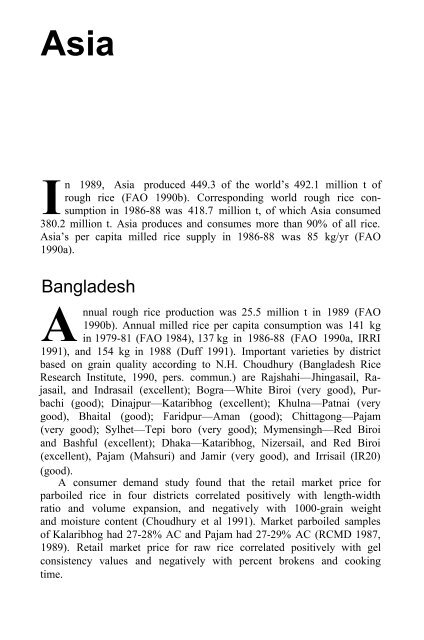Juliano et al. - 1993 - Grain Quality Evaluation of World Rices
Juliano et al. - 1993 - Grain Quality Evaluation of World Rices
Juliano et al. - 1993 - Grain Quality Evaluation of World Rices
Create successful ePaper yourself
Turn your PDF publications into a flip-book with our unique Google optimized e-Paper software.
Asia<br />
I<br />
n 1989, Asia produced 449.3 <strong>of</strong> the world’s 492.1 million t <strong>of</strong><br />
rough rice (FAO 1990b). Corresponding world rough rice consumption<br />
in 1986-88 was 418.7 million t, <strong>of</strong> which Asia consumed<br />
380.2 million t. Asia produces and consumes more than 90% <strong>of</strong> <strong>al</strong>l rice.<br />
Asia’s per capita milled rice supply in 1986-88 was 85 kg/yr (FAO<br />
1990a).<br />
Bangladesh<br />
A<br />
nnu<strong>al</strong><br />
rough rice production was 25.5 million t in 1989 (FAO<br />
1990b). Annu<strong>al</strong> milled rice per capita consumption was 141 kg<br />
in 1979-81 (FAO 1984), 137 kg in 1986-88 (FAO 1990a, IRRI<br />
1991), and 154 kg in 1988 (Duff 1991). Important vari<strong>et</strong>ies by district<br />
based on grain qu<strong>al</strong>ity according to N.H. Choudhury (Bangladesh Rice<br />
Research Institute, 1990, pers. commun.) are Rajshahi—Jhingasail, Rajasail,<br />
and Indrasail (excellent); Bogra—White Biroi (very good), Purbachi<br />
(good); Dinajpur—Kataribhog (excellent); Khulna—Patnai (very<br />
good), Bhait<strong>al</strong> (good); Faridpur—Aman (good); Chittagong—Pajam<br />
(very good); Sylh<strong>et</strong>—Tepi boro (very good); Mymensingh—Red Biroi<br />
and Bashful (excellent); Dhaka—Kataribhog, Nizersail, and Red Biroi<br />
(excellent), Pajam (Mahsuri) and Jamir (very good), and Irrisail (IR20)<br />
(good).<br />
A consumer demand study found that the r<strong>et</strong>ail mark<strong>et</strong> price for<br />
parboiled rice in four districts correlated positively with length-width<br />
ratio and volume expansion, and negatively with 1000-grain weight<br />
and moisture content (Choudhury <strong>et</strong> <strong>al</strong> 1991). Mark<strong>et</strong> parboiled samples<br />
<strong>of</strong> K<strong>al</strong>aribhog had 27-28% AC and Pajam had 27-29% AC (RCMD 1987,<br />
1989). R<strong>et</strong>ail mark<strong>et</strong> price for raw rice correlated positively with gel<br />
consistency v<strong>al</strong>ues and negatively with percent brokens and cooking<br />
time.

















